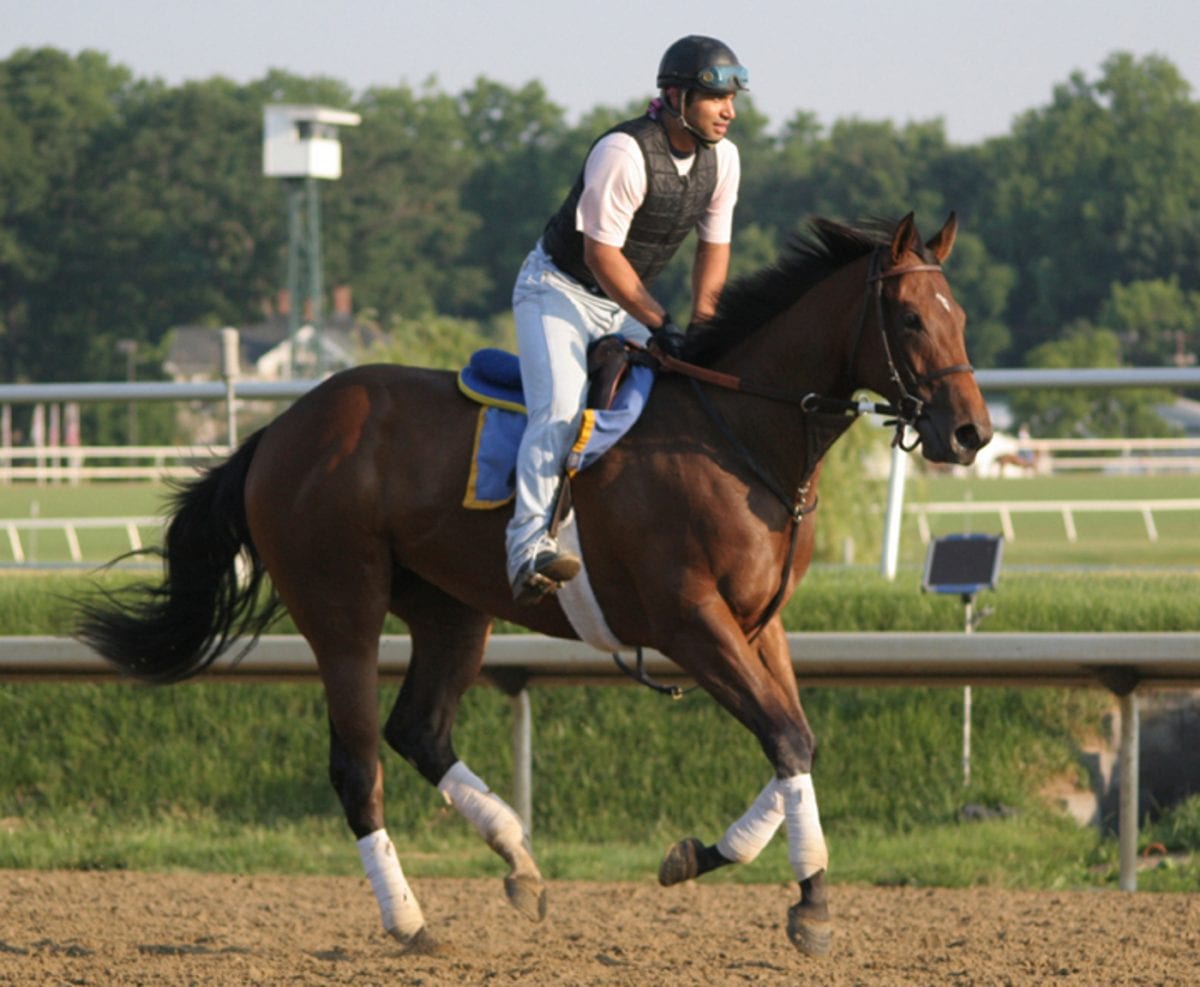by Teresa Genaro
[boxify cols_use =”3″ cols =”6″ position =”right” box_spacing =”5″ padding =”3″ border_width =”3″ border_color =”blue” border_style =”solid” height =”955″ ]What is the national uniform medication policy?The National Uniform Medication Program is a four-pronged approach to responsible use of therapeutic medication in horse racing.
Part 1 is a drug classification system that separates substances into controlled therapeutic medications and prohibited substances, setting thresholds for use and withdrawal guidelines for the 26 approved therapeutic medications.
Part 2 requires that the anti-bleeding medication furosemide (Lasix/Salix) be administrated by regulatory, not private, veterinarians.
Part 3 mandates that laboratories that test for prohibited substances be accredited by the Racing Medication and Testing Consortium’s code of standards.
Part 4, adopted by the Association of Racing Commissioners International last summer, mandates increased penalties for multiple medication violations.
In order to take effect, the measures need to be passed by individual state racing commissions or, in some cases, legislatures. The status of each measure in racing jurisdictions is recorded by Horse Racing Reform.
In the mid-Atlantic, Delaware, Maryland, and Virginia have “fully adopted” the program, according to the site. West Virginia, Pennsylvania, and New Jersey are in the adoption process, with the the former two states’ Racing Commissions having passed them.
[/boxify]To some observers, the most damning element of the People for the Ethical Treatment of Animals (PETA) video of trainer Steve Asmussen’s barns is that it reveals nothing that violates racing’s medication rules.That video, released in March and covered by The New York Times, purported to show what really goes on behind the scenes of a top racing barn. Among other things, it showed horses treated with Lasix and for various ailments, along with numerous often profane discussion of them; and it includes a lengthy segment on the handling of one runner with injured feet.
Some racing leaders, including The Jockey Club and Frank Stronach, have seized on the video to support a call for medication reform and to threaten to seek federal oversight of Thoroughbred racing because, as a letter from The Jockey Club chairman Ogden Mills Phipps said, “inaction feeds the negative perceptions of our sport and lends credence to the charge that we are incapable of broad-based reform,” citing what he sees as slow progress in medication reform.
Those who challenge that perception — who say that racing has, in fact, made progress in restricting the use of medication — point to the National Uniform Medication Program (see box at right), which has been approved by the Racing Medication and Testing Consortium (RMTC), the Association of Racing Commissioners International (ARCI), and the American Association of Equine Practitioners (AAEP).
The core question, though, was raised last month by trainer Terri Pompay in Raceday 360: “Where is the point of abuse?”
To the AAEP’s Dr. Kathleen Anderson and the RMTC’s Dr. Dionne Benson, the line lies within the National Uniform Medication Program. And the key to discerning that line is proper diagnosis.
Benson is the executive director and chief operating officer of the RMTC, positions she has held since July 2012. She completed an internship at Rood and Riddle Equine Hospital in Lexington, Kentucky and designed and executed a clinical study on peri-neural and intra-articular joint blocks at the University of Minnesota. She worked as a veterinary assistant at Canterbury Park and a detention barn technician for the Minnesota State Veterinarian’s office. Prior to becoming a veterinarian, Benson was a practicing attorney.
“If we are able to get [the National Uniform Medication Program] passed, the rules are going to be very restrictive,” asserted Benson, “more restrictive than any other professional sport. They are designed to ensure the integrity of the sport, as well as its safety and welfare of horses and human participants.”
One of the proposed rules designates not only what medications can be used, but also when they can be used, stipulating how far in advance of a race they must be administered. While avoiding performance enhancement or its appearance, the thresholds also seek to permit pre-race vet checks to be unaffected by medication.
“The thresholds for medication residues are designed to ensure that if the tests are below the thresholds, there will be not be an amount [of medication] in the horse sufficient to have an effect on the horse [on race day],” she explained. In other words, if a sick or injured horse had been medicated in advance of a race, the medication would be out of its system by the day of the race, permitting the raceday vet to assess the horse’s soundness unmasked by medication.
Benson also pointed out that approving 26 medications for use in horses is not a recommendation that they all be used on every horse. The expectation is that all medical treatment would be based on a veterinary diagnosis, and not, she said, the diagnosis of “racehorse.”
Recognizing that such ethical behavior is left largely up to the scruples of trainers and private vets, Benson said that oversight of them comes at least in part through the national medication program, emphasizing that use of the controlled therapeutic substances, when found below the recommended thresholds, has no effect on safety, health, welfare, or integrity.
As a third-party Lasix administrator for the Kentucky Horse Racing Commission (KHRC), Benson says that a vet in such a role can and should increase security simply by her very presence.
“It gets practicing vets out of the stall on race day,” she said. And, she said, if, for example, on the course of her rounds, she hears a shockwave machine being used, she’ll ask for the tattoo and the name of the horse it’s being used on.
“Hearing Dr. [Mary] Scollay [equine medical director of the KHRC] talking about it, she encourages us to act like eyes and ears on the backside. If states aren’t using it that way, they should be. “
Among the flashpoints of the PETA video was what appeared to be the injection of a substance into a horse’s joint; the administration of intra-articular corticosteroids is often viewed by the public as deleterious to equine health and a contributing factor in breakdowns.
Both Benson and Anderson say that such treatment is in fact appropriate—under certain circumstances.
“There is a time and place for the injection of corticosteroids,” Benson said. “It will stop the inflammatory process, and in some cases, the inflammatory process can cause more damage than an injection with a corticosteroid. The overuse or misuse will certainly cause damage to a joint; injections of corticosteroids should be done only with full knowledge of what’s going on in that joint. Radiographs are a great tool; they can distinguish synovitis [inflammation of the membrane lining a joint] from damage to the joint. But you need to be able to distinguish synovitis from a chip.”
Anderson is the vice-president of the AAEP. A native of Canada, she worked as a barn manager, international competition groom, and racetrack exercise rider before becoming a veterinarian. She began her veterinary career in Massachusetts based at the United States Equestrian Team training headquarters and Suffolk Downs; then worked her way south from the Meadowlands to Laurel Park through all the tracks in between, including Monmouth, Atlantic City, Garden State, Philadelphia Park, Delaware Park and Pimlico. Twenty years ago, she purchased a veterinary practice at the Fair Hill Training Center.
Anderson expressed a similar view on the use of corticosteroids, using as an example a horse with an inflamed ankle.
“You can take radiographs. If he’s got clean radiographs, you could treat this joint therapeutically, or you could put him on a low dose of systemic medication, for example phenylbutazone or another anti-inflammatory, or you could do nothing.
“The ‘nothing phase,’ although it may sound better to some, may have a longer term of inflammation. In a sense, you could have more damage to the joint than if you medicate the joint and nip it in the bud,” she said.
The key, she said, is diagnosing and treating the problem.
“Typically, if we have a horse with an inflamed joint, we would medicate with a hyaluronic acid plus a short-acting anti-inflammatory to reduce the destructive inflammatory enzymes that are in the joint and then allow the hyaluronic acid to do its job before resuming full return to work,” she elaborated. “In my opinion, it is the right thing to do for these horses because you’re alleviating the inflammation in the joint and allowing that horse to heal better.”
Both Benson and Anderson noted that given the withdrawal times for the medication under the proposed rules, the medications will have cleared the joint at about 72 hours before a horse is entered to race.
“One of the things we kept in mind with intra-articular corticosteroids is that not only did we want time for the medication to be out of a horse’s system before a race,” said Benson. “We wanted time for the vet to see whether the treatment was effective and whether the horse should be racing.”
“We’re going to have time,” Anderson stressed, “to evaluate that horse prior to racing without medication masking clinical signs to be sure that he is healthy and fit to train and compete.
“Corticosteroids aren’t inherently evil; I think we need to use them judiciously, and they shouldn’t be used without knowledge of what is happening in the joint.”
The problem, said Benson, is not how many times a horse has been injected, but why a horse has been injected.
“The danger we run into is,” she observed, “if you have a horse claimed and someone wants to inject six joints and run it back, which has nothing to do with whether the horse needs it. It has nothing to do with diagnosing the horse.”
Anderson also acknowledged that the general public is, in large part “naïve and uninformed” about equine veterinary medicine.
“A pivotal point in the [New York Times] article that [Joe] Drape wrote on PETA was a reference to ‘no pulse’ in the foot,” she said. “That’s a normal finding, but the public doesn’t know that it is normal, and Drape didn’t know. It sounded bad, so it must be bad. The whole thing is very complicated and a very large subject to wrap your hands around. We have to put it into bite-sized pieces and try to understand that there’s gray everywhere you turn.”
She also admitted that all the rules in the world won’t be able to eliminate abuse, but she expressed faith in the integrity of horsemen and horsewomen across the racing spectrum.
“In the world where you have quality horses, quality trainers, and good horsemen trying to do a good job, this is the kind of thought process that goes on,” she said, referring to the importance of using medication in response to a specific diagnosis. “I’ve worked at lower purse tracks. I started out at Suffolk Downs. There were many good horsemen at Suffolk Downs because they often had ‘blue collar’ horses. They had to learn how to manage their horses in order for them to be able to continue to race successfully. A lot of it was done with horsemanship techniques: ice, poultices, not overtraining them—all of those types of things.”
“There are just some poor horsemen, too,” she said frankly. “The business has changed a lot; there are people that have far less ground-level experiences than the old-school trainers, people who come from all walks of life with no prior horse experience before they came to the racetrack. I’m not knocking that; I’m just saying that there’s a wide range of horsemanship skills.”
And she is as frustrated as anyone by the slow pace of reform—which, she pointed out, was due in some cases to the workings of state government.
“West Virginia wants to be in compliance; they’ve already agreed in principle to the reform and voted it through. However, it takes almost two years to change the West Virginia rules,” she said. “They expect to have everything laid out by July 2014, but they’ve actually been on board for the last 18 months. They just haven’t been able to get it done on a legislative level. Charles Town has a lot of critics, but it’s not because they’re not trying on a legislative level, but because it simply takes that long for the process.”
Still, she said, there’s reason for optimism.
“Change is in the works. It’s not that way at every racetrack, but if we were to go to a national uniform medication policy with the regulations the way they’re laid out right now, it would improve a significant portion of the racetracks currently operating,” she stated.
“Whether [medication abuse] is perception or reality,” said Benson, “there has to be increased attention to activity on the backside. We have to allow appropriate and professional medical care; we also have to balance that with where the line is beyond that.”
“Every race horse I care for is an athlete,” observed Anderson. “Some are in the minor leagues, some are in the majors. My job is to help them be the best they can be within the rules of fair play.
“I do not believe that sports medicine has to be a crime, and I feel that’s often how it’s looked at. There’s nothing wrong with wanting to win. It’s how you go about it.”
(Featured photo by Laurie Asseo.)











